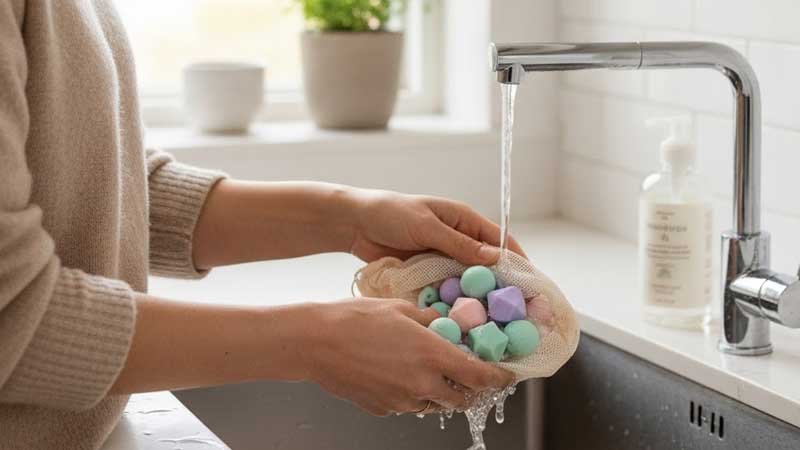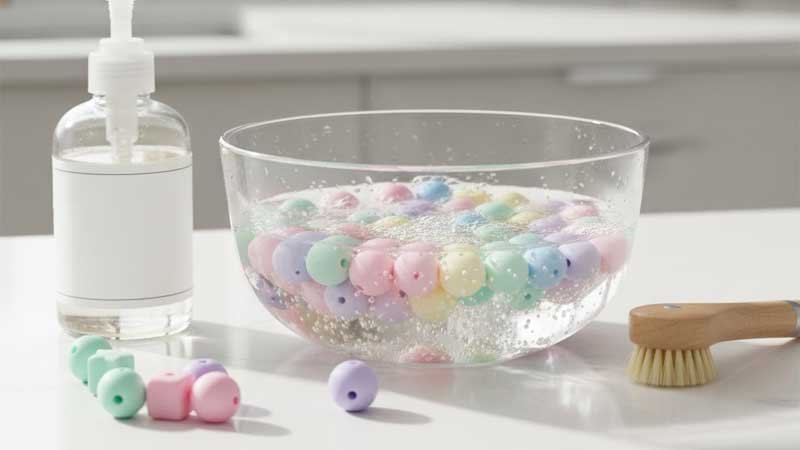Silicone is a type of polymer elastomer. It is known for its heat resistance, water resistance, mold resistance, UV protection, and non-toxic, odorless properties. Unlike plastic, silicone has no pores on its surface, making it less likely to harbor bacteria. However, prolonged exposure to air can still lead to the accumulation of dust, oils, or skin secretions. Regular cleaning is necessary to maintain its cleanliness and shine.

How to Clean Different Types of Silicone Beads?
The cleaning method and frequency of silicone beads vary depending on their use. For example, baby teethers and pacifier clips require cleaning after every use, while silicone beads used for jewelry or crafts only need weekly maintenance. The table below shows simple care guidelines for different types of silicone beads:
| Type | Common Uses | Recommended Cleaning Method | Cleaning Frequency |
| Food-Grade Silicone Beads | Teethers, pacifier clips | Wash with warm water and mild soap | After each use |
| Jewelry-Grade Silicone Beads | Necklaces, bracelets | Wipe gently with a soft cloth or rinse lightly | Once a week |
| DIY Craft Beads | Handmade accessories, decorations | Rinse occasionally to remove dust | As needed |
| Industrial Silicone Beads | Seals, cushioning pads | Wipe with isopropyl alcohol | Regular inspection |
How to Clean Silicone Beads Daily?
Daily cleaning is essential for keeping silicone beads clean. Proper cleaning ensures that they remain smooth, soft, and safe for long-term use. Here are the steps:
- Preparation: Before cleaning, remove any metal rings, cords, or plastic components to prevent scratching the silicone during the process.
- Cleaning: Use warm water and a fragrance-free, mild detergent. Gently agitate the beads to allow dirt and grime to loosen. Avoid using cleaners with alcohol, chlorine, or bleach.
- Light Brushing: For beads with small crevices or textured surfaces, use a soft toothbrush to gently scrub away any hidden dirt.
- Rinsing: Rinse thoroughly with clean water to remove all soap or cleaning agent residue.
- Drying: Let the beads air dry naturally. Do not use a dryer or expose them to direct sunlight, as this can cause the silicone to age or discolor faster.
- Inspection: Once dry, gently press the bead surface to ensure there is no sticky feel or odor before using or storing. This is especially important for baby products, as leftover cleaning agents or damp surfaces can affect safety and usability.

How to Deep Clean and Disinfect Silicone Beads?
For heavily used, contaminated, or baby-related silicone beads, a more thorough cleaning or disinfection is recommended.
- Boiling Water Method: Place the silicone beads in boiling water for 2-3 minutes. This method is suitable for food-grade or medical-grade silicone, but avoid soaking any metal parts.
- Steam Disinfection: Use a baby bottle sterilizer. It is both safe and helps maintain the silicone’s softness.
- Dishwasher: If the product instructions allow, place the beads in the top rack and use a gentle cycle, but avoid high-temperature drying.
- UV Sterilization: UV sterilization is suitable for jewelry-grade or medical-grade silicone. It effectively disinfects without damaging the silicone’s surface.
What Are Common Mistakes in Cleaning?
Many people make small mistakes during the cleaning process. These mistakes can damage silicone beads:
- Using cleaning liquids with alcohol or bleach can cause the surface to turn white or lose elasticity.
- Storing the beads before they are fully dry can lead to unpleasant odors or a sticky surface.
- Leaving silicone beads under direct sunlight for extended periods can cause aging or discoloration.
- Contact with other plastics or oils may cause the beads to absorb odors or develop an oily film.
Though these issues seem like small details, they can significantly affect the appearance, durability, and safety of the product.

Conclusion
Silicone beads require proper, routine cleaning and care. Keeping them clean is not only about appearance but also about safety and overall user experience. By mastering the right cleaning methods, choosing the appropriate cleaning frequency, and ensuring they stay dry and hygienic during storage, silicone beads can retain their softness, safety, and durability for a long time.
At our factory, we specialize in custom silicone products for global brands. From design to production, every detail is handled with care and expertise. Contact us today to start your silicone customization project.